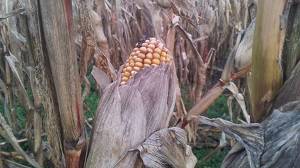For the first time, is drug waste found in agricultural crops. In the North Brabant Someren researchers have found a low concentration waste of ecstasy production in maize which was normally sold as livestock feed.
 The corn stands on a field and is not harvested. The accompanying ranch was dismantled a large ecstasy lab in March last year. Criminals were producing MDMA there for millions of ecstasy pills. Chemical Waste disappeared into slurry pits. The farmer has racked Last spring some of the contaminated manure on his land and planted corn there.
The corn stands on a field and is not harvested. The accompanying ranch was dismantled a large ecstasy lab in March last year. Criminals were producing MDMA there for millions of ecstasy pills. Chemical Waste disappeared into slurry pits. The farmer has racked Last spring some of the contaminated manure on his land and planted corn there.
According to the municipality of Someren now appears that MDMA-debris in the corn plants. The Dutch Food Safety Authority confirms that there is "light levels" drug waste are found. Because an investigation is pending, the service will give no further details. The maize according to the NVWA is not end up in the food chain.
'No risk to humans'
"Environmentalists until now were far from that drug waste was not taken directly by plants," says consultant Jordi van der Steen of the Environment Department Central and West Brabant, who also did research in Someren. "The corn in Someren shows that MDMA residues can indeed end up in plants and thus in the food chain, as it polluted liquid manure is spread."
Yet experts estimate the health risks of the incident in Someren provisionally as small. "There is no risk to humans," expects toxicologist Tinka Murk from Wageningen University. "But this kind of natural substances do not belong in plants at home." She stresses that can only be rendered a good judgment if all research data are complete.
Also, if a cow or pig would eat the contaminated corn has probably minor effects, thinks toxicologist Martin van den Berg of the University of Utrecht. "A pig has a metabolism which is similar to that of humans. By the time it is ripe for chops, the substance is broken down."
Worrisome toxicologists found that drug waste nearly a year after the dismantling of ecstasy lab still is not cleaned up from the slurry pits. "Something like that will not let you down, because that keeps smoke," says Van den Berg. "That can cause breathing difficulties and headaches."
Around the farm it stinks still to chemicals. Local residents are angry and worried. "It is an irritation on the airways," said neighbor Antoinette Meulendijks. "The smell does not stop. When the cellars are emptied, there are harmful substances in, what it does to humans and animals? We get no response. There is quite laconic response from the municipality."
Residents have recently sent a letter to the mayor of Someren sent with the request to clean up drug waste, but got the brush-off. The Environment Department has advised all last spring to remove the contaminated manure as soon as possible. "There there are chemical processes that can be life threatening," says consultant Van der Steen. "There is a risk of leaks, soil pollution and that it ends up in the groundwater."
High cleanup costs
Someren say they are not responsible for clearing and refers to the Dutch Food Safety Authority. These service points back to the municipality. Possibly in Someren with high abandonment costs, thinks the Environment Agency. "Someren is a complicated matter because several governments are involved. It can run in the barrels to clean it up."
The costs from the farmer is at present difficult. He is a suspect in the case, but not the owner of the land. He is also a trace according to the municipality of Someren. The Public Prosecutor and the NVWA expect the investigation is completed in this matter in a few months.
NOS.nl/ © Herman Founder

Reactie plaatsen
Reacties